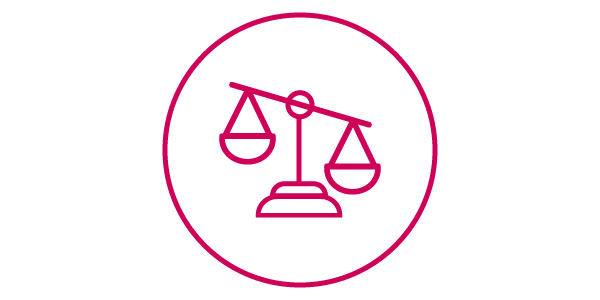
Five Principles for Meaningful Online Assessment
1. Focus on learning
Effective assessment helps students focus their learning on the most important aims of a course. Stating learning outcomes in clear, accessible language and directly linking assessment tasks to those outcomes supports student learning and success. Think about what you want students to learn and how they will demonstrate their learning.

Strategy: Incorporate constructive alignment
Constructive alignment – the principle of designing courses by aligning learning outcomes, teaching and learning strategies, and assessments – increases transparency and course cohesion so students can focus on articulating their learning rather than guessing what is expected of them.
Revisit your course learning outcomes and determine how they relate to the assessment tasks. If there is a misalignment, you may need to adapt your assessments or clarify your learning outcomes. Clearly articulate to students how each assessment provides opportunity for them to demonstrate their learning related to one or more of the outcomes.
Biggs, J. Enhancing teaching through constructive alignment. High Educ 32, 347–364 (1996). https://doi.org/10.1007/BF00138871
Strategy: Use rubrics
Using rubrics helps students understand what high quality learning looks like and the criteria by which their learning will be assessed. Using a rubric can also help you (and any teaching assistants) grade with greater speed, consistency and transparency.
Design a quality rubric for each assessment task that includes criteria, descriptors and performance levels. There are many examples online to get you started. You can then integrate the rubric right into D2L.
Brookhart SM (2018) Appropriate criteria: Key to effective rubrics. Frontiers in Education. 3:22. doi: 10.3389/feduc.2018.00022
Strategy: Teach students how to use the technology prior to assessment
Not all students will be familiar with online learning software and tools.
- Start with the Templates for Blended and Online Learning tools. You can use these to share information with students and/or gather information from them.
- If you are going to use specific online tools for assessment, plan a low-stakes or no-stakes practice session for students to learn the technology before they need to use it in a graded situation.
2. Balance structure with flexibility
Structure and predictability are important in online learning, but providing meaningful flexibility can also help support students achieve the learning aims of the course.

Strategy: Provide flexibility by allowing students some choice about assessment weights
Allowing students some choice in assessment processes may increase motivation and self-regulation as well as promote equity by allowing students to minimize the impact of barriers related to access.
Allow students to choose how much weight will be given to various types of assessments tasks.
Example:
Option 1:
- 10% 4 quizzes (2.5 % each)
- 10% Article review
- 50% 2 Case study assignments (25% each)
- 30% Open book exam
Option 2:
- 20% 4 quizzes (5 % each)
- 10% Article review
- 40% 2 Case study assignments (20% each)
- 30% Open book exam
Jopp & Cohen. (2020) Choose your own assessment – assessment choice for students in online higher education. Teaching in Higher Education, pages 1-18. DOI: 10.1080/13562517.2020.1742680
Strategy: Provide flexibility by allowing students some choice about how they demonstrate their learning
Following principles of Universal Design for Learning (UDL) – see the Taylor Institute UDL Guide or Incorporating Universal Design for Learning in Disciplinary Contexts – increases equity by providing options for a wider range of learners. Providing some options that are less dependent on students owning top notch technology helps level the playing field.
Some courses may also allow students to choose the type of assessment task. For example, students can demonstrate the same learning outcomes by writing a paper, recording a presentation, or creating a digital poster. The key to this kind of choice is using a common set of criteria that applies across formats. See Principle 1 for information on how to create a good rubric with clear criteria.
If you need help setting up this kind of system in a D2L gradebook, see the eLearn site.
O’Neill. (2017). It’s not fair! Students and staff views on the equity of the procedures and outcomes of students’ choice of assessment methods, Irish Educational Studies, 36:2, 221-236, DOI: 10.1080/03323315.2017.1324805
3. Provide clear instructions and quality feedback
Clear communication is essential in online learning. Consider the options available to clarify the aims and expectations of an assessment task as well as to provide students with meaningful feedback.

Strategy: Design with transparency and clarity in mind
Research has shown that providing more details about the purposes, requirements, and grading criteria of an assessment enables all students to focus on demonstrating their learning in the most effective ways.
These benefits have been shown to be even more significant for first-generation and historically underrepresented student groups (see TILThighered.com).
Add flexibility, accessibility, and transparency to your assessment design and instructions by using the Transparent Assignment Instructions Template.
Winkelmes, M. (2023). Introduction to Transparency in Learning and Teaching. Perspectives In Learning, 20 (1). Retrieved from https://csuepress.columbusstate.edu/pil/vol20/iss1/2
Strategy: Take advantage of annotation options and audio- and video-recording tools in D2L
Let’s face it - assessment is time consuming. But research shows that providing timely, specific, actionable feedback is one of the most impactful things teachers can do to support student learning. Recording feedback while you are grading can save time and improve clarity while supporting learning.
When you are reviewing assessments collected in the D2L dropbox – whether a graded final project or an ungraded draft – you can audio or video-record your feedback while you are looking at each assignment. Note that D2L can also integrate rubrics (see Principle 1) as a source of feedback.
Wisniewski, Zierer, & Hattie. (2020). The power of feedback revisited: A meta-analysis of educational feedback research. Frontiers of Psychology. 10:3087. DOI: 10.3389/fpsyg.2019.03087
4. Consider alternative forms of assessment
Assessment in online settings is significantly different than in face-to-face settings. While timed exams are ubiquitous in on-campus courses, online assessment requires a careful re-think of the role of exams.

Strategy: Use alternatives to tests and quizzes
In online assessment, the key is to limit the possibility that technology limitations or glitches will negatively impact students’ ability to demonstrate their learning. While proctoring tools do exist, they have significant limitations and raise new equity concerns. On the positive side, there is a wide range of thoughtful, creative alternatives to assess student learning.
- Check out the extensive range of possibilities for Alternative Online Assessments. From annotated bibliographies to e-portfolios, there are ideas for every kind of course.
- If you are looking for examples of virtual labs and online simulations for your online assessment, see the extensive resources from LabXchange.
Strategy: Use open book exams
Open book, or open resource, exams provide robust opportunities for students to connect course materials with their previous learning by analysing, synthesising, critiquing, and/or evaluating information.
Adapt the following tips to effectively implement an open book exam in your course. Try to have a TA or another instructor look through the exam to anticipate any student confusion or questions so that you can revise instructions or add a Frequently Asked Questions section.
- Consider a 24-hour time frame for students to access the exam.
- Be explicit about how long students will have to complete the exam once they have accessed it.
- Include word ranges or word limits for each type of response for clarity of expectations and to ensure a reasonable grading process.
- Limit the need for students to create graphs/charts/complex diagrams if they will require technological expertise that may be a barrier.
- Focus on higher level thinking questions (aka ungoogleable questions) such as “What would happen if…”; “Why do these two theorists/groups/researchers disagree about…”; “Read this paragraph and discuss how it relates to the concept of….”
- Require students to explicitly draw on course materials. If you want citations, provide clear instructions about how to do that.
- Decide if/how you will enable students to ask you questions during the exam. Also clarify if and how you will respond.
- Weleschuk, Dyjur, & Kelly. (2019). Online assessment in higher education. Taylor Institute for Teaching and Learning Guide Series
5. Promote academic integrity
Academic integrity is a core value of the University of Calgary. Academic integrity is the foundation of the development and acquisition of knowledge and is based on values of honesty, trust, responsibility, and respect. We expect members of our community to act with integrity.

Strategy: Keep the focus on promoting learning, not on avoiding cheating
As educators, our role includes assessing in ways that are appropriate and fair for the learning environment. Using the above principles can help to mitigate concerns about academic integrity.
- Whether in face-to-face or online learning environments, conversations about academic integrity should happen early and often.
- See the specific strategies for using D2L quizzes (such as question randomization) and online assessment in the UCalgary resources on academic integrity and online learning.
- Ensure students are familiar with the Academic Integrity Student Handbook.
